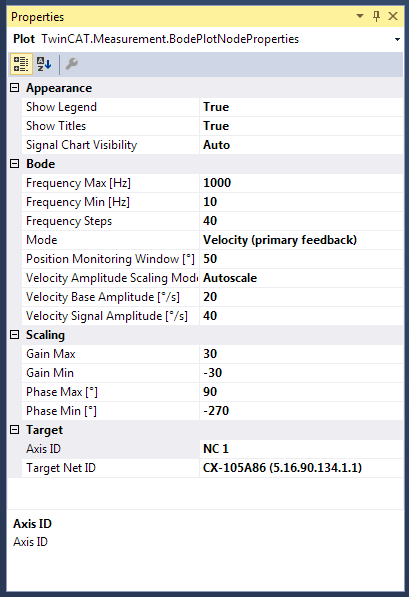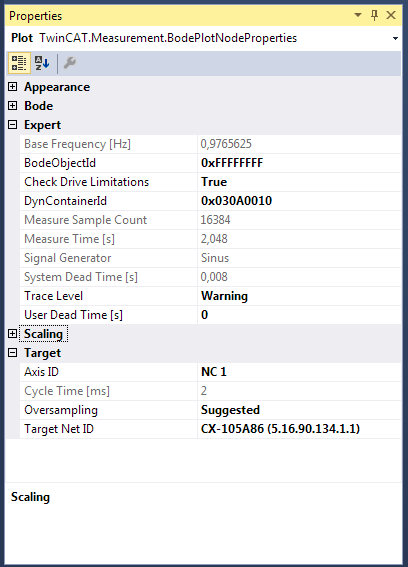Bode Plot - Plot properties
All settings for a Bode plot can be assigned here. The following description refers to the representation in categories (switchable in the Properties toolbar).

Appearance
- Show Legend: Indicates whether the legend should be shown in the footer of the Bode Plot editor.
- Show Titles: Indicates whether the headings of the charts should be shown in the Bode Plot editor.
- Signal Chart Visibility: Indicates whether the chart with setpoint and actual values of the recording should be shown or hidden. If Auto is set, the chart is only shown during a running recording.
Bode
Under this category all settings are summarized in order to configure a new Bode Plot.
- Frequency Max: Indicates the upper frequency limit of the Bode Plot [in Hz].
- Frequency Min: Indicates the lower frequency limit of the Bode Plot [in Hz].
- Frequency Steps: Number of interpolation points in the Bode Plot.
- Mode: Sets the Bode Plot mode. The following are available
- Torque: Executes a Bode Plot for the torque (or current) interface. (AX5000 only)
- Velocity (primary feedback): Executes a Bode Plot for the velocity interface. The actual values of the primary encoder are used for this. (AX5000 only)
- Velocity (dp/dt directly from primary feedback): Executes a Bode Plot for the velocity interface. (AX5000 only)
- Velocity (secondary feedback): Executes a Bode Plot for the velocity interface. The actual values of the secondary (external) encoder are used for this. (AX5000 only)
- Position (NC interface without oversampling): Executes a Bode Plot for the position.
- Velocity (NC interface without oversampling): Executes a Bode Plot for the velocity.
- Torque (NC interface without oversampling): Executes a Bode Plot for the torque (or current).
The following settings are shown or hidden, depending on the mode.
- Position Monitoring Window [°]: Defines a window that is monitored during the Bode plot. The object must not leave this window. The unit actually set is read out and the number is interpreted in accordance with the unit.
- Position Signal Amplitude [°]: The amplitude of the excitation is set here.
- Velocity Amplitude Scaling Mode: Scales the signal amplitude during the recording so as to not have to make excessively large movements as the frequency increases. The following are available:
- Constant: The amplitude corresponds to the parameterized signal amplitude and remains constant over the entire frequency range.
- 1 / X at 1000Hz: Scales the amplitude so that at 1000 Hz it has fallen to 1/X of the start amplitude at 1 Hz (~1/f). Useful ratios in practice are 1/5, 1/10 and 1/20.
- Torque Amplitude Offset: Specifies an offset for the torque amplitude [in %].
- Torque Amplitude Scaling Mode: Scales the signal amplitude during the recording, depending on the current frequency. The following are available:
- Autoscale: Scales the amplitude so that it is somewhat larger than the noise at a standstill.
- Constant: The signal amplitude remains the same over the entire frequency range. The amplitude 100 means 100 % of the maximum current.
- Torque Signal Amplitude: Sets the amplitude of the signal (or measuring) oscillation at 1 Hz (cf. Torque Amplitude Scaling Mode). The unit of measurement is to be taken from the system settings (e.g. Drive, NC, etc.) and cannot be specified here.
- Velocity Base Amplitude: Sets the amplitude of the basic oscillation (~1 Hz) for overcoming the static friction. The unit of measurement is to be taken from the system settings (e.g. Drive, NC, etc.) and cannot be specified here.
- Velocity Signal Amplitude: Sets the amplitude of the signal (or measuring) oscillation at 1 Hz (cf. Velocity Amplitude Scaling Mode). The unit of measurement is to be taken from the system settings (e.g. Drive, NC, etc.) and cannot be specified here.
Scaling
- Gain Max: Indicates the upper magnitude for the value axis in the chart of the amplitude response.
- Gain Min: Indicates the lower magnitude for the value axis in the chart of the amplitude response.
- Phase Max: Indicates the highest scale end in the chart of the phase response.
- Phase Min: Indicates the lowest scale end in the chart of the phase response.
Target
- Axis ID: indicates the ID of the drive axis that is to be used for this Bode Plot. WARNING
- Target Net ID: indicates the ID of the target system on which the drive axis is located that is to be used for this Bode Plot.
Extended View
If "View Detail Level" in the Bode project settings is set to Extended, some additional properties are visible.

Expert
- Base Frequency: Shows the frequency [in Hz] of the basic oscillation for overcoming the static friction (in the velocity modes only).
- Bode Object Id: If the Bode Plot is to take place via a "Drive Diag TcCom Object" already set up in the System Manager (e.g. in order to scope additional process data from the drive), this can take place here via the Object ID.
- Check Drive Limitations: If a check of the drive is to take place, this can be specified here.
- DynContainerId: Sets the ID of the container for dynamic process data. The DynContainer is appended to the EtherCAT device in the TwinCAT project.
- Measur Sample Count: Indicates the number of setpoint values and actual values from which an interpolation value of the Bode characteristic curve (a frequency point) is calculated.
- Measure Time: Indicates the length of time [in s] for which the system is excited with one frequency.
- Signal Generator: Indicates the curve type of the signal generator used.
- System Dead Time: The complete dead time can be entered here in seconds.
- Trace Level: Sets the detail level of the messages generated by the “Drive Diag –TcCom Object” and displayed in the error list. The available options are Always, Error, Verbose and Warning.
- User Dead Time: The dead time in seconds can be specified here.
Target
- Cycle Time: Indicates the last-used cycle time [in ms].
- Oversampling: Indicates the oversampling factor to be used. If set to "Suggested", the highest useful factor is automatically selected when starting the recording.